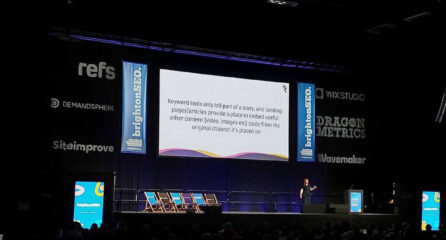If you’ve created videos to market your business but you’re not sure how to get them in front of the right audience, this article is for you.
At Loom we’re video marketing experts with a wealth of experience in helping our clients to get their videos seen. We’re passionate about making your video content work as hard as possible to achieve your goals.
This article is going to explore how digital marketing can help your video reach the right audiences, have the most impact and achieve your marketing goals.
If you want to find out more about our video marketing services and how we can help you contact us today.
Why is marketing your video important?
You can make the greatest video content in the world, but if no one sees it, it won’t generate results for your business. That’s why marketing your video is crucial.
So, don’t waste your time and money on making a video without also having a plan on how to market it. Instead, create a video promotion strategy to help your video reach its target audiences effectively.
Before we talk about how to do that, let’s look at the three main reasons why it’s vital to get your online video promotion strategy right:
1. Successful online promotion will get you a return on your investment
Whether you’ve created your own marketing videos or paid someone else to create them, you’ll have already invested your personal time and money into your video.
This investment of time and money should be proportionate to how much business these video assets create for you. So, by marketing your videos to the right audience online, you’re far more likely to see a return on that investment.
2. You’ll improve your business’ branding and voice
Video can convey human emotions and tell stories better than many other marketing formats. Popular UK supermarkets have created viral Christmas ads based on this principle for years.
Videos can also be key in creating or maintaining a brand voice or personality. Video reviews, testimonials and how-to’s are some of the most successful and powerful marketing assets when it comes to selling products or services online. For example:
- Almost 50% of web users look for a video before visiting a store, says Google.
- 84% of consumers have bought something after watching a video. Wyzowl
3. You can target specific audiences with tailored online video content
Online marketing lets you target specific audiences far more effectively than TV ads. This means marketing videos online can better reach your audiences – and for less money! Most platforms will allow you to target audiences based on:
- Demographics
- Age
- Gender
- Interests
- Remarketing
- How people use your website, which pages they use etc.
- Lookalike audiences
- Audiences similar to how people use your website
So, before you start your video marketing strategy: consider who your audience is, what they want to know and where they spend time online.
Once that’s done, you can plan your video marketing campaign around them, ensuring you show them the right content on the right platform and at the right time in their conversion journey.
Which video marketing platforms to use
Uploading your video content to the right online platform is important if you want to reach your target audiences. Choosing the right channel will depend on who you want to reach with your video.
Think about your audience’s online behaviours. Ask yourself:
- Which websites do your audience most commonly use?
- What devices do they use to go online?
- How long do they spend and when are they online?
- What types of content do they read and watch?
Pro Tip: To get helpful data about your audiences, use Google Analytics. The ‘Audiences’, ‘Acquisition’ and ‘Behaviour’ tabs are particularly helpful when building a picture of who your current audiences are and how they behave online. You can then create the best videos for your target audiences using the intelligence you’ve gathered.
Thom Popejoy, Account Manager
These data insights will point you towards the perfect platforms to market your video content. Let’s take a look at a few of the most popular online video platforms.
Video marketing on YouTube
YouTube is the second biggest search engine in the world and is used across the globe by people of all demographics. It’s the perfect platform for video content because of its popularity, but it also offers many other features for marketers. These include:
Video SEO: YouTube is owned by Google and acts as a search engine for video content. This means there is an opportunity to optimise video content for search. YouTube allows video content to be optimised for search engines by providing opportunities to write metadata and uploaded transcripts.
Google Ads: Google Ad users can place video ads over video content in Google. (find more info on this below)
Functionality: YouTube is very easy to access and use. The app is designed to work well on both desktop and mobile devices. YouTube also makes it easy to share videos with other platforms too.
Video marketing on Instagram
Instagram is one of the fastest emerging platforms for online content. Originally a place to upload photos, videos are now becoming a focal aspect of the platform.
Most commonly used on smartphones and tablets, Instagram is a great platform for shorter videos. If you’re not familiar with this app here are some stand out stats collated by Hootsuite:
- 1 billion people use Instagram every month
- 71% of Instagram users are under the age of 35
- 72% of US teens use Instagram
- 500 million people use Stories every day
- An 80% increase of video uploaded year-by-year
- Instagram is owned by Facebook
When it comes to targeting, Instagram is popular with younger demographics, and more brands have started to use the platform to reach this audience.
Instagram’s “Stories” feature allows audiences exclusive access to celebrities and influencers and is often in the form of video content.
Video marketing on Facebook
Facebook is still the most popular social media platform in the world. 2.23 billion people log into Facebook every month. User demographics start to look a little different to Instagram with a higher proportion of older people regularly using Facebook and a rapidly decreasing number of millennials logging in regularly.
Facebook has great internal analytics tools included too so you can learn about your audience’s behaviour whilst they are on the platform.
According to Sprout Social “Facebook is the second favourite platform for consuming videos after YouTube. 40% of consumers said that they watch the most videos on Facebook.”
It’s also a platform that social marketers prefer to use, with 70% of them choosing Facebook ads as the most useful for achieving their goals. Users can control and manage their Instagram video ads through Facebook too.
Case study: One client of ours produced a series of 6 second, USP focused videos to push out to their Remarketing lists on Facebook. Working to a CPA of £16, we were able to optimise performance and deliver 36 conversions across a 6 week period at a CPA of just £9.60 – That’s 40% below the client’s goal. By understanding your audience and targeting them with the right content at the right time, videos can be a valuable asset for your Facebook campaigns.
Vicky Hockley, Senior Account Manager
Video marketing via your own website
It’s a great idea to post your videos on your own website. Whilst social media platforms are great outreach tools, videos on your website can quickly communicate your offering or service to your website users in a way that they’re becoming increasingly used to.
Depending on the way your website has been built, most websites will display video using YouTube to stream the media from. Embed code for the media file is inserted into the HTML code of your site to display media files.
Pro Tip: Place videos on landing pages to your site; typically, your home page and any page that you are linking users to through online ads. This will help to improve the bounce and exit rates for that page. Use a strong conversion call to action at the end of your video to encourage people to follow a link through to your conversion pages.
Thom Popejoy, Account Manager
Marketing videos with Google Ads
There are several types of video that can be used as ads on paid platforms, and this can be a very effective way to market your video.
Videos make great ads because they attract and hold attention much more than text ads.
When marketing videos through Google Ads, video ads are uploaded to YouTube and the channel is linked to your Google Ads account. Managing your video ads is done in the Google Ads platform.
These video ads can be sent to specific, and custom, groups of people using targeting tools in Google ads. Google also creates custom audiences based on factors like general interests (Affinity Audiences) or email lists that can be uploaded to the Google ads platform (Customer Match)
Pro tip: When you run video ads on Google ads, it’s important to remember that YouTube ads rely on Google Ads for tracking – rather than Google Analytics. Make sure to set up your conversion points with Google Ads conversion tracking – this will ensure that any automated bidding strategies can improve the effectiveness of your video ads. Contact the PPC team on [email protected] for more information.
Tommy Pearson – Head of PPC
The types of Google Ads video ads
Google Ads offers lots of ways to market your videos as ads. For example: In-stream Video Ads – A skippable ad format that appears when you watch a video on YouTube.
They are viewed in YouTube but also show in Google Display Network properties that are opted in for video.
- 15 – 30 seconds in length although there is no limit
- Skippable after 5 seconds
- First 5 seconds are vital – get the viewer’s attention
- Get your proposition across and logo in for brand awareness
- Voice over and subtitles should be included
- Include uniform call to actions and endplate
- List on your brand channel
Bumper Video Ads – A short, un-skippable video ad that plays before or during a video in YouTube
They are viewed in YouTube but also show in Google Display Network properties that are opted in for video.
- These ads are used for remarketing purposes
- They are unskippable
- Are 6 seconds in length
- Should have very visible branding
- Should be hidden from your brand channel
- Feature voice-over and subtitles, with your brand logo throughout
- Ideal for use in Facebook as-well
Adapt your video content for different channels
As you can see, there are lots of different ways to market your video online, and it makes sense to take advantage of more than one platform.
So, adapting your video to perform best on each of the above platforms is very important. There are lots of ways to do this:
1. Make new edits of the videos you already have to make your content work harder.
By re-editing a video asset that fits the requirements of a particular online channel, you’ll multiply your useful marketing assets and help you to reach new audiences wherever they are online.
Re-edits could include:
- Changing the length
- Altering the aspect ratio of the video
- Converting the file format to another format
- Adding or taking out the brand positioning
- Changing the messaging
- Adding subtitles
2. Apply customer intent-driven keyword research to your video transcript and metadata (title tag, meta descriptions, header tags).
SEMrush, Keywords Everywhere and VidIQ all have onboard tools to help you find relevant keywords for your video content.
3. Create an engaging thumbnail image to represent your video.
If your video is sitting in a long feed of content, make sure the thumbnail or first frame is eye-catching.
4. Harness hashtags to reach communities of like-minded people.
There are two main types of hashtags that can be used on Instagram. Knowing which group to pull from will ultimately help users to find your feed and story videos on Instagram. Branded hashtags are specific to your business or sector – your brand name, sales campaigns or specific products are all in this group. Community hashtags are often created around wider topics that are being posted about nationally or internationally. #truevintage or #nationalcharityday are examples of community hashtags.
Optimise your video length for different channels
Lastly, video lengths, formats, ratio sizes and even audiences should be considered when uploading video content to different platforms.
Below we’ve listed the video specifications for the various platforms we’ve discussed in this article.
Recommended YouTube video specifications
- Length: According to HubSpot videos lasting 2 minutes get the most engagement. Longer content works too, as people use YouTube as a search engine. The length of your video will really depend on the types of videos you are uploading. A brand awareness video piece should be much shorter than an in-depth interview piece or behind the scenes documentary.
- Formats: MOV, MP4 (MPEG4), AVI, WMV, FLV, 3GP, MPEG-PS, WebM.
- Ratio Sizes:
Recommended Facebook video specifications
- Length: Short videos are king on Facebook, this is because users scroll through their feeds until something captures their attention. They can often only watch the first 10 seconds before scrolling past. Anywhere from 1 minute to 2 minutes can work as long as you have a strong introduction. Create videos that users will want to share.
- Formats: DIVX, AVI, MPEG, DV, 3GP, 3GPP, 3G2, WMV
- Ratio Sizes: 1280 x 720 for Landscape and Portrait. Minimum width is 600 pixels (length depends on the aspect ratio) for Landscape and Portrait. Portrait aspect ratio is 9:16 (if the video includes link, aspect ratio is 16:9).
Recommended Instagram video specifications
Instagram allows content publishers to upload a variety of different lengths of video.
- Instagram feed video length: 3 – 60 seconds,
- Instagram Story video length: 15 seconds per video but multiple stories can be uploaded at the same time. Instagram will edit a video longer than 15 seconds down into 15-second snippets and play them consecutively
- Instagram Live Video length: Up to an hour.
- Formats: MP4, MOV
- Ratio Sizes: A square sized 1080px video using a 30fps frame rate.
Video lengths on Instagram have started to get longer depending on what type of video is uploaded. However, most commonly, 30 second – 1-minute videos have the most engagement. User metrics from mobile platforms reflect a ‘short-attention-scroll’ behaviour – short punchy videos are therefore perfect for young Instagram users.
Loom Digital: experts in marketing videos online
If you want to know more about how to promote your video content online, get in touch with the experts at Loom Digital.
Our multiskilled team have award-winning knowledge and expertise across several marketing disciplines including video marketing. We work with a wide range of different businesses, helping them reach their audiences with exciting and insightful video content.
Whether you’re looking for help with your marketing video content creation or promotion strategy, we can help you. Get in touch with us on 0117 923 2021 or email us at [email protected].





